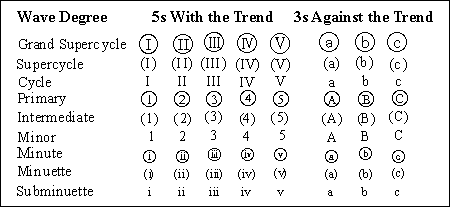Degrees
When numbering and lettering waves, the scheme shown below is recommended to differentiate the degrees of waves in the stock market's progression:

The most desirable form for a scientist is usually something like 11, 12, 13, 14, 15, etc., with subscripts denoting degree, but it's a nightmare to read such notations on a chart. The above table provides for rapid visual orientation. Charts may also use color as an effective device for differentiating degree.
In Elliott's suggested terminology, the term "Cycle" is used as a name denoting a specific degree of wave and is not intended to imply a cycle in the typical sense. The same is true of the term "Primary," which in the past has been used loosely by Dow Theorists in phrases such as "primary swing" or "primary bull market." The specific terminology is not critical to the identification of relative degrees, and the authors have no argument with amending the terms, although out of habit we have become comfortable with Elliott's nomenclature.
The precise identification of wave degree in "current time" application is occasionally one of the difficult aspects of the Wave Principle. Particularly at the start of a new wave, it can be difficult to decide what degree the initial smaller subdivisions are. The main reason for the difficulty is that wave degree is not based upon specific price or time lengths. Waves are dependent upon form, which is a function of both price and time. The degree of a form is determined by its size and position relative to component, adjacent and encompassing waves.
This relativity is one of the aspects of the Wave Principle that make real time interpretation an intellectual challenge. Fortunately, the precise degree is usually irrelevant to successful forecasting since it is relative degree that matters most. Another challenging aspect of the Wave Principle is the variability of forms, as described through Lesson 9 of this course.
Wave Function
Every wave serves one of two functions: action or reaction. Specifically, a wave may either advance the cause of the wave of one larger degree or interrupt it. The function of a wave is determined by its relative direction. An actionary or trend wave is any wave that trends in thesame direction as the wave of one larger degree of which it is a part. A reactionary or countertrend wave is any wave that trends in the direction opposite to that of the wave of one larger degree of which it is part. Actionary waves are labeled with odd numbers and letters. Reactionary waves are labeled with even numbers and letters.
All reactionary waves develop in corrective mode. If all actionary waves developed in motive mode, then there would be no need for different terms. Indeed, most actionary waves do subdivide into five waves. However, as the following sections reveal, a few actionary waves develop in corrective mode, i.e., they subdivide into three waves or a variation thereof. A detailed knowledge of pattern construction is required before one can draw the distinction between actionary function and motive mode, which in the underlying model introduced so far are indistinct. A thorough understanding of the forms detailed in the next five lessons will clarify why we have introduced these terms to the Elliott Wave lexicon.
END OF PART 4, END OF LESSON 1.



